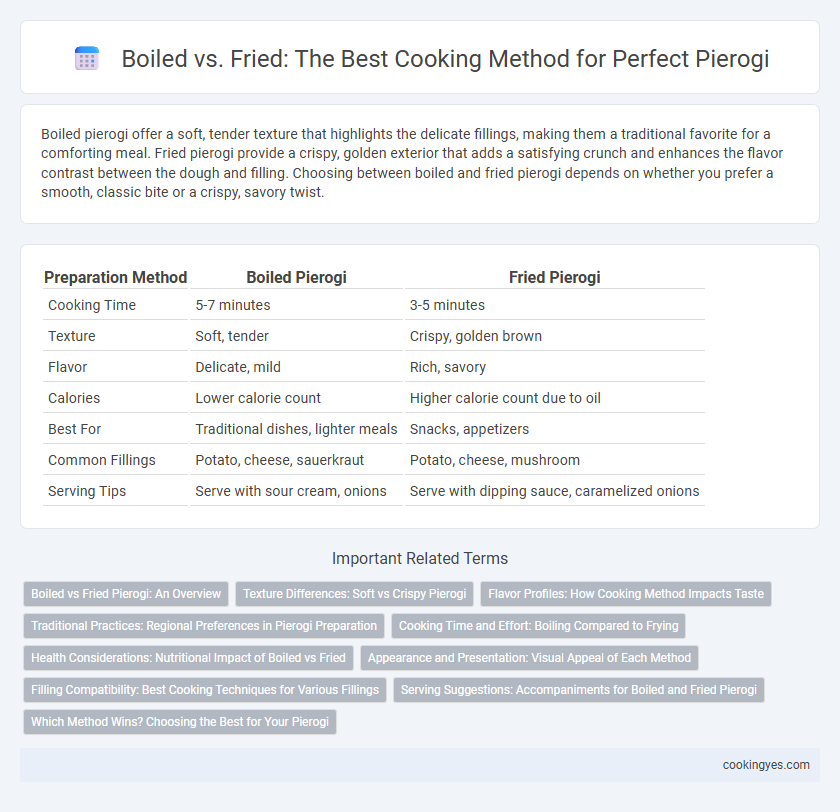Boiled pierogi offer a soft, tender texture that highlights the delicate fillings, making them a traditional favorite for a comforting meal. Fried pierogi provide a crispy, golden exterior that adds a satisfying crunch and enhances the flavor contrast between the dough and filling. Choosing between boiled and fried pierogi depends on whether you prefer a smooth, classic bite or a crispy, savory twist.
Table of Comparison
| Preparation Method | Boiled Pierogi | Fried Pierogi |
|---|---|---|
| Cooking Time | 5-7 minutes | 3-5 minutes |
| Texture | Soft, tender | Crispy, golden brown |
| Flavor | Delicate, mild | Rich, savory |
| Calories | Lower calorie count | Higher calorie count due to oil |
| Best For | Traditional dishes, lighter meals | Snacks, appetizers |
| Common Fillings | Potato, cheese, sauerkraut | Potato, cheese, mushroom |
| Serving Tips | Serve with sour cream, onions | Serve with dipping sauce, caramelized onions |
Boiled vs Fried Pierogi: An Overview
Boiled pierogi offer a soft, tender texture with a slightly chewy bite and retain moisture, making them ideal for creamy or saucy fillings such as potato and cheese or sauerkraut. Fried pierogi develop a crispy, golden exterior with a rich, savory flavor, enhancing fillings like ground meat or mushrooms through caramelization. Both methods influence the final taste and texture, with boiling preserving filling integrity and frying adding a crunchy contrast that appeals to different culinary preferences.
Texture Differences: Soft vs Crispy Pierogi
Boiled pierogi have a soft, tender texture that highlights the dough's elasticity and the filling's moisture. Fried pierogi develop a crispy, golden-brown exterior that contrasts with the soft interior, providing a satisfying crunch. The choice between boiled and fried preparation significantly impacts the overall sensory experience, balancing softness with crispiness.
Flavor Profiles: How Cooking Method Impacts Taste
Boiled pierogi have a tender, doughy texture that highlights the creamy, savory fillings like potato and cheese, offering a mild and comforting flavor profile. Fried pierogi develop a crispy, golden exterior that adds a rich, buttery crunch and intensifies the caramelization of the dough, enhancing the overall taste with a slightly nutty and toasted flavor. The choice between boiling and frying pierogi significantly impacts the mouthfeel and depth of flavor, making frying preferable for those seeking a more robust, crunchy experience, while boiling appeals to fans of soft and delicate textures.
Traditional Practices: Regional Preferences in Pierogi Preparation
Boiled pierogi remain the traditional preparation method in Eastern European regions such as Poland and Ukraine, preserving the dough's soft and tender texture while highlighting the filling's flavor. Fried pierogi, popular in areas like Silesia and parts of Slovakia, add a crispy golden exterior that enhances contrast and richness. Cultural preferences dictate cooking techniques, with boiled pierogi often served with sour cream or butter, whereas fried versions frequently accompany onions or bacon for added savory depth.
Cooking Time and Effort: Boiling Compared to Frying
Boiling pierogi typically requires 5-7 minutes and involves less active effort, making it a quick and straightforward method. Frying pierogi takes longer, about 8-10 minutes, and needs more attention to ensure an even golden crust. The boiling method preserves a softer texture, whereas frying enhances crispiness but demands more cooking time and skill.
Health Considerations: Nutritional Impact of Boiled vs Fried
Boiled pierogi retain more nutrients and contain fewer calories and less fat compared to fried versions, making them a healthier option overall. Frying pierogi increases their fat content significantly due to oil absorption, which may contribute to higher cholesterol levels and calorie intake. Choosing boiled pierogi supports lower sodium and saturated fat consumption, beneficial for cardiovascular health and weight management.
Appearance and Presentation: Visual Appeal of Each Method
Boiled pierogi have a smooth, pale, and slightly glossy surface that highlights their plump, doughy texture, often served with a light butter or sour cream topping for a soft, inviting presentation. Fried pierogi boast a golden-brown, crispy exterior with slightly blistered edges, offering a visually striking contrast between the crunchy shell and the tender filling inside. The choice between boiled and fried pierogi affects not only texture but also the overall visual appeal on the plate, influencing how appetizing and restaurant-worthy the dish appears.
Filling Compatibility: Best Cooking Techniques for Various Fillings
Boiled pierogi retain a soft, tender texture that complements delicate fillings like mashed potatoes, cheese, and sauerkraut by preserving their moisture and subtle flavors. Fried pierogi develop a crispy exterior that enhances robust, hearty fillings such as ground meat, mushrooms, or cabbage, adding a contrasting crunch and intensified taste. Selecting the ideal cooking method depends on the filling's moisture content and desired texture balance, ensuring optimal flavor and mouthfeel for every pierogi variety.
Serving Suggestions: Accompaniments for Boiled and Fried Pierogi
Boiled pierogi pair excellently with melted butter, sauteed onions, and sour cream, offering a classic, comforting flavor profile perfect for traditional meals. Fried pierogi develop a crispy, golden exterior that complements toppings like crispy bacon bits, caramelized onions, or a dollop of tangy creme fraiche, enhancing texture and richness. Serving boiled pierogi with fresh herbs such as dill or chives adds freshness, while fried pierogi benefit from a sprinkle of smoked paprika or grated cheese to elevate the savory experience.
Which Method Wins? Choosing the Best for Your Pierogi
Boiled pierogi offer a tender, moist texture that highlights the filling's flavor, making them ideal for delicate or creamy stuffings. Fried pierogi develop a crispy, golden exterior, adding a satisfying crunch and enhancing savory fillings like potato or meat. Selecting the best method depends on your preferred texture and taste experience, with boiled for softness and fried for crispiness.
Boiled vs Fried for Pierogi Preparation Infographic

 cookingyes.com
cookingyes.com